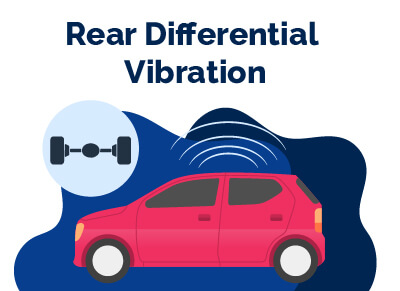7 Common Causes Of Rear Differential Vibrations
July 21, 2023


Chris is Head of Content for FindTheBestCarPrice and is based out of Philadelphia, PA. As a seasoned automotive industry analyst and car enthusiast, he ensures the highest level of quality across all our content and curates our picks for the best deals each month.
Chris studied information systems and marketing at Drexel University and writes about a wide range of topics ranging from car buying tips to troubleshooting common mechanical issues.
When he’s not thinking about cars, he likes to stay in with his dog and make an “attempt” to finish a crossword puzzle (he’s not quite at the Saturday/Sunday level…yet). As a former cheesemonger, Chris still has a “sharp” passion for all things cheese, and his fridge is always loaded with it!
Chris also has a passion for things that go fast, and drones are no exception. He spends some of his time writing for Dronesourced.
The rear differential is an integral component of your automobile's mechanics, enabling the transmission of torque and rotational motion through elongated shafts trailing the vehicle's entire length.
Its fundamental purpose is to provide for the distinct rotation of all four wheels, a prerequisite for ensuring optimal grip and stability. When the rear differential goes bad, symptoms such as rear differential vibrations can begin to occur.
Notably, tracking down the source of rear-end vibrations can prove more challenging than pinpointing FWD vibrations. Determining the origin of driveline tremors in an RWD vehicle can pose a significant challenge.
As with FWD automobiles, ensuring that your tires are of good quality and balanced adequately before delving into the driveline is crucial.
Table of Contents
What Is a Rear Differential?
Rear differentials are fundamental components of a rear-wheel-drive vehicle that act as gear trains, directing power to the wheels for optimal driving, especially when turning.
Various rear differentials exist, including limited-slip, automatic or manual locking, open, and torque-vectoring options.
Each type offers unique benefits that depend on the application and intended use of the vehicle. While not an exhaustive list, these four options are the most prevalent in the automotive market.
Limited-slip differentials allow the vehicle to provide alternate torque to each tire, minimizing slipping while driving on corners and uneven terrain.
Automatic or manual locking differentials enable the axles to lock together, providing the best possible traction, especially in off-roading situations with uneven terrain or the risk of getting stuck in mud, dirt, or sand.
Open differentials provide power to the wheels while allowing independent turns, which can minimize hopping, instability, and uneven tire wear.
Torque-vectoring differentials are standard in high-performance cars and deliver torque to one wheel, allowing the vehicle to rotate and providing exceptional operation control, particularly in under or over-steering situations. This feature can also aid in improving fuel economy.
Where Is the Rear Differential Located?
In a rear-wheel-drive vehicle, the rear differential is situated at the posterior end of the vehicle on the rear wheel axle, interposed between the two rear wheels. It serves to interconnect the transmission or transfer case through the driveshaft.
Causes of Rear Differential Vibrations
There exist several intriguing reasons why rear differential vibrations occur. A prevalent cause of this phenomenon is the insufficiency of lubrication. Here are some additional factors to consider:
1. Worn Out Pinions and Ring Gears
Ring and pinion gears are crucial in intentionally transmitting power to the wheels. However, when these gears malfunction or entirely break down, the wheels fail to receive sufficient power, producing vibrations throughout the vehicle.
Furthermore, when accelerating, you may notice a howling or whining noise, even at lower speeds. Several factors, such as overloading, heavy-duty use, and pinion misalignment, can lead to the failure of these gears.
If you encounter this problem, it is imperative to act promptly and have the pinion and ring gears repaired or replaced. Seeking the guidance of a qualified automotive expert can be of great help in resolving these issues.
2. Damaged Teeth
A dysfunctional or damaged rear differential can also cause vibrations in the vehicle due to damaged teeth within the differential.
This condition hinders the smooth rotation of the differential, thereby creating instability. To put it simply, faulty differentials have fractured teeth.
Furthermore, a defective drive shaft can cause inaccurate wheel turns when driving around corners or making turns, resulting in an overall reduction in control over the vehicle.
When you experience any driveshaft issues, it is crucial to address them promptly. Book an appointment with a reputable repair shop to have it fixed. Failing to do so may harm other parts of the drivetrain.
3. Faulty Universal Joints
Universal joints (U-joints) are essential to link the differential and driveshaft, enabling the latter to traverse lateral movements. They can connect two drive shafts or connect the driveshaft to the transmission.
However, when these joints break or fail, they cannot connect appropriately, leading to vibration.
Moreover, if the bearings at each end of the joint break, the natural movement of the driveshaft cannot be achieved, resulting in unwanted vibration.
In this scenario, it is advisable to conduct a thorough examination to determine if there is a problem with the U-joints. If an issue exists, replacing the entire U-joints assembly is recommended to obtain a favorable outcome.
4. Unsuitable Lubricants
Appropriate differential fluids are crucial to ensure adequate lubrication and optimal differential performance. However, if an incorrect lubricant is applied, it can impede the differential's functionality and generate strange noises and vibrations.
This is deemed to be the primary reason for differential wear and tear. Inferior quality or inappropriate differential fluid can foster corrosion or rust buildup, causing the differential to seize up or lock. As a result, the wheels will spin badly, generating vibrations.
5. Insufficient Lubrication
Using the appropriate lubricant is imperative for maintaining the differential's optimal functionality. When the differential fluid level drops below the recommended level, it reduces rotational speed or immobilization.
This phenomenon exerts additional stress on the differential, culminating in the gear teeth grinding, leading to unwanted vibrations. It is common for the system to work harder to compensate for insufficient lubrication.
As a result, the differential has to exert more force to deliver the required power to the wheels, especially when cornering, to maintain their rotational velocity. In certain instances, the gear teeth can break due to excessive strain.
Recommended Course of Action: It is essential to adhere to the recommended fluid change schedule and ensure that the correct lubricant is used. Driving a vehicle with inadequate fluid or lubrication levels should be avoided.
6. Uneven Tire Wear
The tire plays a pivotal role in ensuring a vehicle's optimal performance. However, due to the additional effort required by the tire to maintain the force or pressure generated by the differential, it is susceptible to premature wear.
Furthermore, the tire's deterioration can harm the suspension, further exacerbating the issue.
Possible Solution: To mitigate the occurrence of premature tire wear, replace the damaged differential.
Additionally, using the appropriate differential fluid is crucial in maintaining the differential's operational continuity. Seeking assistance from a qualified mechanic is advisable.
7. Differential Fluids Leakage
Interm incessant fluid leakage is another prevalent cause of vibration stemming from a defective differential. The insufficient fluid supply hinders the differential's ability to perform optimally.
Consequently, the differential teeth fail to engage flawlessly, and the rotation falters, leading to vibrations from the rear or the entire car.
Possible Solution: Inspect the gasket, pinion seal, and differential side panel seal to identify possible fluid leakage points.
If any leaks are found, taking prompt action or seeking guidance from an experienced mechanic is crucial.
Functions of a Rear Differential
The rear differential plays a role in ensuring an automobile's seamless functioning. These components can be found in rear-wheel, all-wheel-drive, and 4WD vehicles, where they perform vital operations.
In all-wheel-drive and 4WD systems, the rear differential is merely one constituent of the steering system.
1. Facilitates Proper Cornering
Rear differentials are essential for smooth turning while driving. They ensure that the inner wheels do not revolve at the same rate as the outer wheels. This function allows the driver to have more command during cornering.
2. Transfers Power From Transmission to Wheels
The transmission conveys power to the driveshaft, which links to the rear differential. This power initiates the rotation of the driveshaft, which, in turn, turns the wheels, propelling the car to move.
3. Modifies Wheel Rotation
Regardless of the type of rear differential installed in your vehicle, they all alter the wheel rotation speed.
While some models may provide more torque to the outer wheels, others secure the power so that both tires spin simultaneously.
Due to these distinctions, how the rear differential modifies the wheel rotation relies on the driving environment and intended purpose.
Best Car Deals by Category
Frequently Asked Questions
What are the common causes of rear differential vibrations?
The common causes of rear differential vibrations are low fluid levels, wrong or low-quality differential fluids, worn-out U-joints or driveshafts, damaged or worn-out rear differential bearings, continuously leaking fluids, and broken teeth.
How do I know if my car is experiencing rear differential vibrations?
You may feel a noticeable vibration or shaking sensation from the rear of the vehicle while driving.
Additionally, there may be strange noises, grinding, or clunking sounds, especially when turning corners or accelerating.
Can I still drive with rear differential vibrations?
While it is technically possible to drive with rear differential vibrations, it is not recommended.
Continuously driving with a damaged or faulty rear differential can lead to more severe damage and costly repairs in the long run.
What should I do if I experience rear differential vibrations?
The best action is to take your vehicle to a qualified mechanic for inspection and diagnosis.
They will be able to determine the root cause of the problem and provide the necessary repairs or replacements.
How often should I change my rear differential fluids?
The recommended interval for changing rear differential fluids varies by make and model, but generally, changing them every 30,000 to 50,000 miles is advised.
It's always best to consult your vehicle's owner manual for the manufacturer's recommended schedule.
Can I fix the rear differential vibrations myself?
Fixing rear differential vibrations requires technical knowledge and expertise, so it is only recommended to attempt repairs yourself if you are an experienced mechanic. It is always better to seek the help of a professional mechanic.
Posted in Car Buying Tips, Car Troubleshooting |




